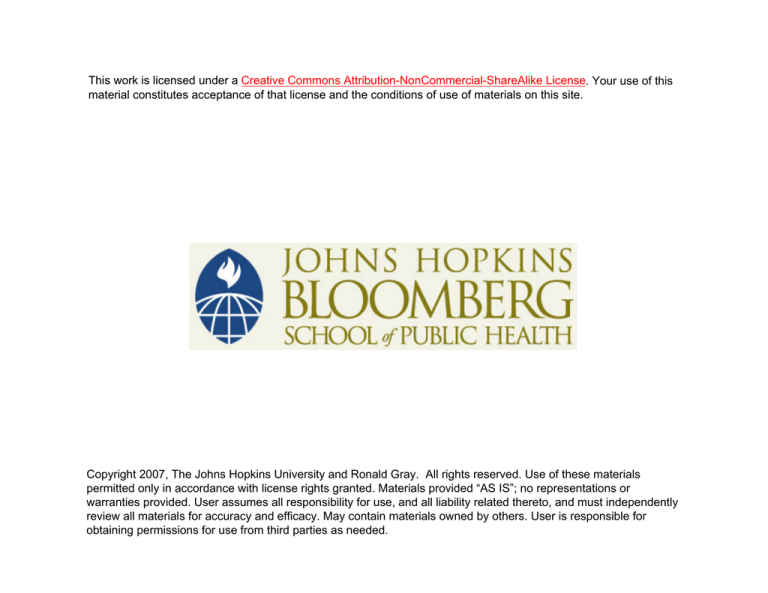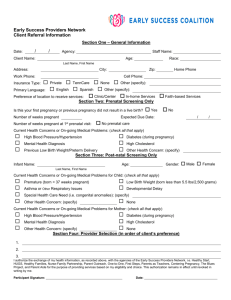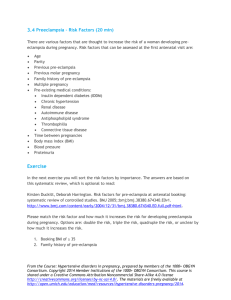
This work is licensed under a Creative Commons Attribution-NonCommercial-ShareAlike License. Your use of this
material constitutes acceptance of that license and the conditions of use of materials on this site.
Copyright 2007, The Johns Hopkins University and Ronald Gray. All rights reserved. Use of these materials
permitted only in accordance with license rights granted. Materials provided “AS IS”; no representations or
warranties provided. User assumes all responsibility for use, and all liability related thereto, and must independently
review all materials for accuracy and efficacy. May contain materials owned by others. User is responsible for
obtaining permissions for use from third parties as needed.
Lecture 12a: Complications
of Pregnancy
Complications of Pregnancy
• Antenatal care (ANC) is intended to detect and treat
or prevent complications of pregnancy
– Ectopic pregnancy
– Toxemia (pregnancy induced hypertension PIH),
precursor of eclampsia
– Diabetes
– Infections
– Anemia
– Birth defects/chromosomal anomalies screening
Ectopic Pregnancy
• Extra-uterine pregnancy in fallopian tubes,
ovary or abdominal cavity
• Rate 1.3-2% of pregnancies
• Mortality:
– US 1970 = 35.5, 1990 = 3.8/10,000
– Developing countries 100-300 deaths/10,000
• Presentation:
– Pelvic pain and vaginal bleeding (> 5-8 weeks
early)
– Shock, hemorrhage, acute abdominal emergency
(late presentation)
– Woman with a missed period or known pregnancy
Risk factors for ectopic pregnancy
(Farquhar Lancet 2005;366:583)
Risk factor
Range of Odd ratios
Tubal surgery,
sterilization
PID
>1 sex partner
Induced abortion
Smoking
Age > 40
IUD
Sterilization
4.7-21.0
Prior ectopic
DES
6.0-11.5
2.4-13.0
2.5-21.0
2.1-2.5
~ 2.8
2.3-2.5
~2.9
4.2-45.0
4.9-18.0
Diagnosis of ectopic pregnancy
– Clinical suspicion (bleeding or lower
abdominal pain in a pregnant woman)
– Serial hCG (normal hCG increases
exponentially, attenuated with ectopic)
– Progesterone (lower in ectopic than normal
pregnancy)
– Transvaginal ultrasound
Trends in ectopic Pregnancy
• Ectopic pregnancy increased in industrialized
countries during 1970s and 80s, and declined
in 1990s
• Risk factors:
– PID (chlamydia)
– Sterilization (15-20% of sterilization failures are
ectopic)
– Increased age at first pregnancy (increased
ectopics with age)
– Improved early diagnosis (hCG and ultrasound)
– IUD use? (increased proportion of pregnancies
with IUD are ectopic. Differential efficacy for intraversus extra-uterine pregnancies)
– Ovulation induction
Source: Kamwendo F, et al. Sex Transm Inf 2000;76:28-32. All Rights Reserved.
Ectopic Pregnancy: Treatment
• Early unruptured ectopics
– Salpingostomy
– Methotrexate
• Ruptured or later ectopics, or
ovarian/abdominal ectopics
– Laparotomy
Hypertension in pregnancy
• Pre-existing hypertension before pregnancy or < 20
weeks gestation; 3-5% of pregnancies)
• Pregnancy associated hypertension (PAH) >20
weeks; no proteinuria; ~6-7% of pregnancies
• Pre-eclampsia, hypertension with proteinuria 5-6% of
pregnancies
• Superimposed hypertension. 25% of women with preexisting hypertension develop pre-eclampsia
• Eclampsia, convulsions in a woman with
hypertension and proteinuria.
Preeclampsia and Eclampsia
• Preeclampsia (toxemia, pregnancy induced
hypertension, PIH)
–
–
–
–
–
BP ≥ 140 mm Hg systolic or ≥ 90 diastolic
Proteinuria ≥ 0.3 g per 24 hours
Edema +/Placental insufficiency 30%
Disturbances of coagulation and liver function
Usually > 20 weeks gestation
Early onset suggests preceding hypertension
• Major risk to mother (eclamptic convulsions)
• Risk to fetus (IUGR/PTD, placental abruption,
stillbirth) due to placental insufficiency or
maternal convulsions
Eclampsia
• Maternal/fetal death
– Rate ~ 0.05% in developed countries
– Rate ~ 0.06-1% in developing countries
– ~50,000 maternal deaths due to eclampsia
Pathophysiology
Unknown (“disease of theories”).
• Endothelial functional abnormalities, possibly related
to immune reaction to paternal antigen in the
placenta,
• genetic factors (some men present greater risk)
• dietary deficiency (calcium)
Risk Factors for Pre-eclampsia and
Eclampsia
•
•
•
•
•
•
•
•
•
•
Previous pre-eclampsia (OR ~ 11)
Nulliparous (OR ~ 5)
Paternal factors (some men increase risk)
Genetic factors, familial history
Calcium deficiency
History of spontaneous abortion (multiparous only,
OR ~ 0.3)
African American (nulliparous only)
Higher body weight
Ovum donation
Smoking (OR ~ 0.45)
Eskanazi JAMA 1991;266:237, Walker Lancet 2000;356:1260
Pre-eclampsia Prevention Trials
• Primary prevention by:
– Low-dose aspirin
– Calcium supplementation
• Secondary prevention
– Magnesium sulphate
– Anticonvulsants
• End points
– Maternal condition
– Infant outcomes
Early Low-dose Aspirin Primary
Prevention Trials
- Six trials before 1991 meta-analysis of small
trials (n = 394)
– PIH
RR = 0.35 (0.22-0.55)
– LBW
RR = 0.56 (0.36-0.88)
– Fetal/neonatal death RR = 0.88 (0.32-2.46)
– No maternal side effects
Imperiale JAMA 1991;266:260
Low-Dose Aspirin Prevention Trials
(Sibai NEJM 1993; 329:1213)
• Low-dose aspirin vs placebo (n=3135)
– PIH RR = 0.7 (CI 0.6-1.0)
– Women with preceding hypertension on
enrollment PIH 5.9% in aspirin vs 11.9%
control (RR = 0.50)
– No effects on PTD or LBW
• Conclusion: aspirin is indicated for women
with preceding hypertension
Low-Dose Aspirin Prevention Trials
CLASP Trial Low-Dose Aspirin (Lancet 1994;343:619)
• Low-dose aspirin for prevention of PIH (n =9364)
– PIH
(RR = 0.87 ns)
– PTD
(RR = 0.88 ns)
• Low-dose aspirin for treatment of PIH
– PIH
(RR = 0.88 ns)
– PTD
(RR = 0.79 ns)
• Conclusion
– No support for routine aspirin prophylaxis
– May be warranted for high risk women?
Calcium Supplementation Trials
• Animal studies suggest that calcium depletion can
cause PIH
• Observational studies suggest an inverse association
between dietary calcium and BP in pregnancy
• 14 trials, mainly in Latin America (<1994), relatively
small numbers (14-588), many not placebocontrolled, mainly high-risk women (e.g., prior
hypertension or PIH)
• Meta-analysis (Bucher JAMA 1996;275:1113)
– Reduction of systolic BP –5.40 mm Hg (-7.81, 3.00)
– Reduction of diastolic BP – 3.44 mm Hg (-5.20, 1.68)
– PIH OR = 0.38 (0.22-0.65)
NICHD Trial (US) Calcium for Preecalmpsia Prevention (CPEP)
Levine NEJM 1997;337:69
• 4,589 healthy nulliparous women 13-21
weeks gestation randomized to 2 g calcium or
placebo
– Preeclampsia RR = 0.94 (0.76-1.16)
– Pregnancy associated hypertension RR =
0.88 (0.78-1.01)
– BP Calcium vs placebo: Systolic –0.3 mm,
diastolic = 0.03mm (ns)
– No effects on PTD, LBW, SGA
Meta-analysis 1999
DeSimonian, Levine JAMA 1999;282:664
• 6 trials with placebo control, separated into
populations at low and high risk of calcium deficiency
• Low-risk populations (n = 1357)
RR = 0.79 (0.44-1.42)
– Preeclampsia in controls = 3.8% (3-7%)
– Calcium intake 600-1200 mg/day
• High-risk populations (n = 225)
RR = 0.19 (0.08-046)
– Preeclampsia in controls = 29% (24-44%)
– Calcium intake 300-600 mg/d
Calcium supplementation and Pre-eclampsia:
Relative Risk Estimates for Placebo-Controlled
Trials
Figure 1. DerSimonian R, et al. Resolving Discrepancies Between a Meta-analysis and a
Subsequent Large Controlled Trial. JAMA 1999;282:664-670. All Rights Reserved.
Calcium Supplementation for Preeclampsia: Conclusions
• No evidence of benefit in low-risk
women
• Probable benefit in high-risk women
– Need multiple trials in different nutritional
settings
– Need placebo control
– Need sub-group analyses
– Need more trials of high risk
Vitamin C and E supplementation
(Briley Lancet 2006; 367:1145)
• 2410 women at risk of pre-eclampsia
randomized to vitamin C and E or placebo
• No effect on pre-eclampsia, increased LBW
(RR = 1.15, CI 1.02-1.30)
Management of pre-eclampsia
• BP ~150 systolic and 90-105 diastolic
– Antihypertensives reduce eclampsia
– may reduce neonatal complications
• BP >160/100
– Antihypertensives indicated
– Reduces fetal and neonatal complications
Magnesium Sulphate for Established
Eclampsia
• 1687 women with eclampsia randomized to
magnesium sulphate IV, or anticonvulsants
(diazapam, phenytoin) IV or IMI
• Recurrent convulsions
– Mag sulph vs diazepam RR = 0.48 (0.36-0.63)
– Mag sulph vs phenytoin RR = 0.33 (0.21-0.53)
– Mag sulph reduced infant complications
Magnesium sulphate for treatment of preeclampsia (Magpie trial, Lancet 2002;359:1877)
• 10,110 pregnant women with BP > 140/90
and proteinuria randomized to magnesium
sulphate IV or placebo (saline)
• Eclampsia
RR = 0.42 (0.29-0.60)
• Maternal death RR = 0.55 (0.26-1.14)
• Perinatal death RR = 0.99 (0.88-1.11)
Magnesium Sulphate for
neuroprotection before preterm birth
(JAMA 2003;290:2669)
• 1062 women at risk of preterm birth <30
weeks. Magnesium sulphate vs placebo
• Severe motor dysfunction or death in
infants RR = 0.75 CI 0.59-0.96
Gestational Trophoblastic Disease
• Hydatidiform mole
– Neoplasm of the placenta (chorion),
forming grape like cysts. Usually no fetus
or dead fetus
–
• Choriocarcinoma
– Malignant cancer of the placenta
Palmer J Reprod Med 1994;39:155
Hydatidiform Mole
• Incidence
– US, Europe ~ 1/1000 pregnancies
– Japan and East Asia 2/1000 pregnancies
• Risk factors
– Older maternal age (>35)
– Previous hydatidiform mole (RR ~ 10)
• Treatment
– dilation and curettage
– Monitor for choriocarcinoma
Choriocarcinoma
• Incidence
– US and Europe ~ 0.05/1000
– Japan and East Asia ~ 0.08-0.23/1000
• Risk factors
– Prior hydatidiform mole (RR ~1000)
– Older maternal age (> 35)
– Type A blood group
• Treatment
– Chemotherapy
Diabetes in pregnancy
Galernau et al Obst and Gynecol Clin of Nth Amer 2004;31:907
• Pre-gestational diabetes
– Pre-existing type 1 or 2 diabetes in a pregnant
woman (~ 4% in US)
– Rates increasing due to obesity and delayed child
bearing
• Gestational diabetes
– Diagnosed in pregnancy (~7% in US)
– Due to insulin resistance
– Risk factor for subsequent diabetes
Complications due to gestational
diabetes
• Maternal
– Increased hypertension and preeclampsia (RR 24)
– SAB (RR ~ 3)
• Infant
– Macrosomia (birth weight > 4 kg),
– Shoulder dystocia
– Birth defects (CNS, cardiovascular) RR ~ 8 vs
nondiabetics
– Metabolic abnormalities, Respiratory Distress
Syndrome (RDS)
– Subsequent diabetes in offspring (5-15%)
Violence During Pregnancy
• Maryland 1993-98 enhanced surveillance of
maternal deaths
– (Horon and Cheng JAMA 2001;285:1455)
• 247 pregnancy associated deaths identified
by record linkage and medical examiner
records
– Homicide leading cause of pregnancy
associated death death (20%)
– Cardiovascular disease (19%)





